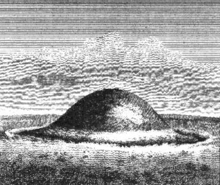77:. There is sometimes present an additional bank, external to the ditch. The ditch is typically the source of the material used to create the mound and is therefore described as a "quarry-ditch". A burial pit beneath the mound usually contains human remains, sometimes cremated, sometimes simply interred. Grave goods such as daggers or pottery vessels are commonly found within the burial pit also. An example at
59:
51:
73:
In the United
Kingdom, they take the form of a circular mound or mounds within a circular ditch, the mounds being separated from the ditch and each other by a
228:
188:
207:
175:
Extract from
English Heritage's Record of Scheduled Monuments: Bell barrow 350m north of Haydon Farm, Sutton Veny
233:
223:
150:
155:
100:
89:
has no burial associated with it. Most bell barrows in the United
Kingdom date to the early
8:
90:
185:
82:
58:
44:
192:
96:
217:
50:
78:
40:
174:
63:
86:
36:
186:
English
Heritage National Monuments Record: Monument No. 918833
74:
81:
included a bronze-age wooden coffin. The bell barrow in
54:
Section and plan of a bell barrow with a narrow berm
215:
210:– English Heritage, archived August 2004
57:
49:
208:Bell Barrows monument class description
216:
116:: A single mound with a normal berm
110:: A single mound with a narrow berm
13:
14:
245:
201:
122:: A single mound with a wide berm
229:Types of monuments and memorials
68:The Ancient History of Wiltshire
179:
168:
1:
161:
23:, sometimes referred to as a
7:
144:
39:identified as such by both
10:
250:
191:October 2, 2011, at the
151:Devil's Humps, Stoughton
156:Devil's Jumps, Treyford
29:campanulate form barrow
70:
55:
61:
53:
16:Type of burial mound
66:'s introduction to
62:A bell barrow from
234:Barrows in England
224:Bronze Age England
103:for bell barrows:
71:
56:
25:Wessex type barrow
241:
195:
183:
177:
172:
83:Milton Lilbourne
45:William Stukeley
249:
248:
244:
243:
242:
240:
239:
238:
214:
213:
204:
199:
198:
193:Wayback Machine
184:
180:
173:
169:
164:
147:
97:Leslie Grinsell
35:, is a type of
17:
12:
11:
5:
247:
237:
236:
231:
226:
212:
211:
203:
202:External links
200:
197:
196:
178:
166:
165:
163:
160:
159:
158:
153:
146:
143:
142:
141:
135:
134:: Three mounds
129:
123:
117:
111:
99:constructed a
15:
9:
6:
4:
3:
2:
246:
235:
232:
230:
227:
225:
222:
221:
219:
209:
206:
205:
194:
190:
187:
182:
176:
171:
167:
157:
154:
152:
149:
148:
140:: Four mounds
139:
136:
133:
130:
127:
124:
121:
118:
115:
112:
109:
106:
105:
104:
102:
98:
94:
92:
88:
84:
80:
76:
69:
65:
60:
52:
48:
46:
42:
38:
34:
33:bermed barrow
30:
26:
22:
181:
170:
137:
131:
128:: Two mounds
125:
119:
113:
107:
95:
72:
67:
32:
28:
24:
20:
18:
79:Sutton Veny
41:John Aubrey
21:bell barrow
218:Categories
162:References
91:Bronze Age
64:Colt Hoare
87:Wiltshire
189:Archived
145:See also
132:Type III
101:typology
138:Type IV
126:Type II
120:Type Ic
114:Type Ib
108:Type Ia
37:tumulus
31:, or a
75:berm
43:and
85:in
220::
93:.
47:.
27:,
19:A
Text is available under the Creative Commons Attribution-ShareAlike License. Additional terms may apply.

